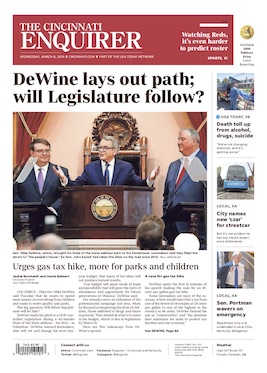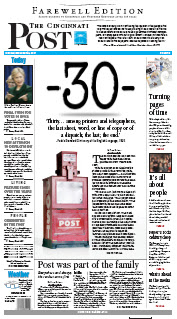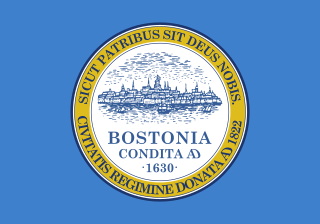
Reading is a city in Hamilton County, Ohio, United States. The population was 10,600 at the 2020 census. It is an inner suburb of Cincinnati and is included as part of the Cincinnati metropolitan area.

Loveland is a city in Hamilton, Clermont, and Warren counties in the southwestern part of the U.S. state of Ohio. The population was 13,307 at the 2020 census. Considered part of the Cincinnati metropolitan area, Loveland is located near exit 52 off Interstate 275, about 15 miles (24 km) northeast of the Cincinnati city limits. It borders Symmes, Miami and Hamilton townships and straddles the Little Miami River. Once a busy railroad town, Loveland is now a major stop along the Little Miami Scenic Trail.

The flags of the U.S. states, territories, and the District of Columbia exhibit a variety of regional influences and local histories, as well as different styles and design principles. Modern U.S. state flags date from the turn of the 20th century, when states considered distinctive symbols for the 1893 World's Columbian Exposition in Chicago, Illinois. Most U.S. state flags were designed and adopted between 1893 and World War I.

The Ohio Burgee is the official flag of the U.S. state of Ohio. It is a triangular swallowtail flag, the only non-rectangular U.S. state flag. Its red, white, and blue elements symbolize the state's natural features and order of admission into the Union. A prominent disc in the flag's triangular canton is suggestive of the state's name. This flag was adopted in 1945.

The flag of Oklahoma consists of a traditional Osage buffalo-skin shield with seven eagle feathers on a Choctaw sky blue field. The buffalo shield is covered by two symbols of peace: the Plains-style ceremonial pipe representing Native Americans, and the olive branch representing European Americans. Six golden brown crosses, Native American symbols for stars, are spaced on the shield.

The Cincinnati Enquirer is a morning daily newspaper published by Gannett in Cincinnati, Ohio, United States. First published in 1841, the Enquirer is the last remaining daily newspaper in Greater Cincinnati and Northern Kentucky, although the daily Journal-News competes with the Enquirer in the northern suburbs. The Enquirer has the highest circulation of any print publication in the Cincinnati metropolitan area. A daily local edition for Northern Kentucky is published as The Kentucky Enquirer.

The Cincinnati Post was an afternoon daily newspaper published in Cincinnati, Ohio, United States. In Northern Kentucky, it was bundled inside a local edition called The Kentucky Post. The Post was a founding publication and onetime flagship of Scripps-Howard Newspapers, a division of the E. W. Scripps Company. For much of its history, the Post was the most widely read paper in the Cincinnati market. Its readership was concentrated on the West Side of Cincinnati, as well as in Northern Kentucky, where it was considered the newspaper of record. The Post began publishing in 1881 and launched its Northern Kentucky edition in 1890. It acquired The Cincinnati Times-Star in 1958. The Post ceased publication at the end of 2007, after 30 years in a joint operating agreement with The Cincinnati Enquirer.

The Great Seal of the State of Ohio is the official insignia of the U.S. state of Ohio. All governmental offices, agencies, and courts in Ohio use variations of the state seal. Its primary feature is a circular coat of arms that depicts a sunrise in Chillicothe, Ohio's first capital, along with symbols of the state's origins. The seal sometimes appears with the state motto, "With God, All Things Are Possible".

The Cincinnati Times-Star was an afternoon daily newspaper in Cincinnati, Ohio, United States, from 1880 to 1958. The Northern Kentucky edition was known as The Kentucky Times-Star, and a Sunday edition was known as The Sunday Times-Star. The Times-Star was owned by the Taft family and originally edited by Charles Phelps Taft, then, by his nephew, Hulbert Taft, Sr. The Taft family's investments in news media would later grow into Taft Broadcasting, a conglomerate that owned radio, television, and entertainment properties nationwide.

The municipal flag of Buffalo is the official banner of the city of Buffalo, New York. The navy blue flag contains a large central emblem consisting of the city seal with 13 "electric flashes" and interspaced 5-pointed white stars emanating from it.

The flag of Pittsburgh is a triband flag featuring vertical bands of black and gold and Pittsburgh's coat of arms in the center.

The flag of Boston consists of a sky blue field and the seal of the city of Boston, Massachusetts, United States, in the center. The flag is sometimes flown in a darker shade of blue, more of a turquoise. It was designed in 1913 and adopted by the Boston City Council on January 29, 1917.

The municipal flag of New Orleans is the representative banner of the U.S. city of New Orleans, Louisiana. The flag has a large white field that contains three gold fleurs-de-lis and is bordered on the top by a red stripe and from below by a blue stripe. The presence of the fleur-de-lis, a stylized depiction of a flower and a traditional French symbol, demonstrates the city's French heritage and strong ties to France.

The flag of Phoenix, Arizona, is the official municipal flag of Phoenix, Arizona. Its current design is a maroon field with a white phoenix emblem in the center. The design is the second in the city's history and has been in place since 1990, replacing a flag that was adopted in 1921.

The flag of Knoxville, Tennessee was officially adopted by municipal ordinance on October 16, 1896. It is the third oldest, official city flag in the United States and the oldest flag of any state or city governmental entity in Tennessee.

The flag of Provo, Utah, is the official flag of the city of Provo, Utah, United States. The present flag, featuring the city's logo on a light blue field, was adopted on January 6, 2015, after a multi-year debate to replace a previous one. The former flag, adopted in 1989, was ridiculed in particular for its perceived ugliness and its similarity to the Centrum logo, and was voted one of the worst American city flags by the North American Vexillological Association (NAVA).

The seal of Cincinnati is the official insignia of the city of Cincinnati, Ohio, in the United States. Adopted in 1819, the seal incorporates scales, a sword, and a caduceus. The seal is featured prominently in the flag of Cincinnati and the insignia of city agencies and institutions.

The flag of Spokane, Washington, is the official municipal flag of Spokane, Washington, United States. Its design comprises a sun in the canton on a white-and-green field separated by a stylized blue river. The flag was adopted in 2021 and is the fourth to be used by the city government.

The flag of Columbus is the official municipal flag of Columbus, Ohio. Its current design is a yellow, white, red vertical triband with the city seal on a blue field. Officially, the flag was adopted in 1929, although it is unknown if the flag was ever flown when it was first adopted.

The flag of Dayton, Ohio, U.S., was adopted on December 15, 2021, and created by Dayton design and marketing firm Catapult Creative. The cost to the city for the design and an accompanying video was $4,300.























